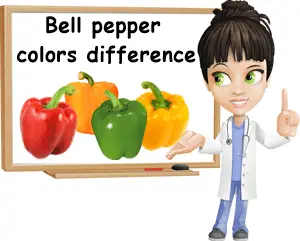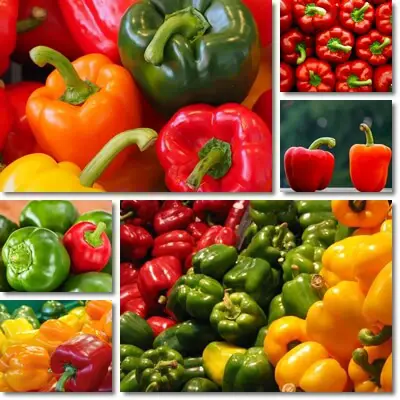What is the difference between bell peppers of different colors? Red, yellow, orange, green and other less common bell pepper colors are essentially the same fruit, just differently colored. But each color brings something different to the table nutrition-wise, not to mention there will also be more or less pregnant differences in taste and flavor profile. For example, green bell peppers are unripe, bitter and high in vitamin K, but low in vitamin A, versus red bell peppers which are ripe, sweet and high in vitamin A, but a lot lower in vitamin K. Purple and black bell peppers have antioxidant anthocyanins, versus red, yellow and orange bell peppers which have antioxidant carotenes and xanthophylls.
So whether your bell peppers are green, red, yellow, orange, white, pale green, brown or chocolaty, lavender, purple or black, or there’s more than one color on them, know that there is some meaning behind the different pigments. The choice for one color or another means getting more of certain vitamins and antioxidants and less of others. Which means more benefits for certain aspects of health versus others.

What causes different bell pepper colors?
The first factor that causes different colors in bell peppers is time of harvest which determines degree of ripening. Basically, harvesting the fruits at different times ensures you get fruits at different stages in their ripening process and, in the case of bell peppers, also different colors. For example, green bell peppers are almost always unripe, being harvested before their time to prevent them from turning another color. Whereas red bell peppers are green first, but left to ripen, they turn red. Actually, all bell pepper colors except green ones are just ripe green bell peppers – yellow, orange, red, orange with red stripes, purple, purple with yellow stripes, chocolate-colored and black bell peppers are initially green, but then ripen and turn all these other colors.
Some bell peppers will change color more than once as they ripen. For example, while some fruits will go from green straight to red or yellow or orange or purple or black, others will go from green to purple and then to black. Some will go from green to orange then develop red stripes. Picking the fruits at different times during their ripening cycle will result in different colors. But color development during ripening hints at another factor that accounts for the differences in bell pepper color.
All bell peppers, irrespective of color, are one cultivated variety, or cultivar. It’s presumed that each and every one of the bell pepper colors available commercially right now evolved over time. Plants exhibiting novelty colors in their fruits were selected for further cultivation. For instance, only certain plants will produce purple or black fruits or orange with red stripes or purple with yellow stripes. Fruits don’t just keep changing color until they’ve went through all of them. That’s because each bell pepper color is a variant of the cultivated variety and will retain certain characteristics (most of the time), one of them being color.

Green vs red bell peppers
For the most part, green bell peppers are unripe and bitter tasting. Versus red which are ripe and one of the sweetest colors. Green is indicative of the presence of chlorophyll, but also carotenoid antioxidants with vitamin A activity (208 micrograms beta-carotene) and without (341 micrograms lutein and zeaxanthin). However, this particular color is relatively low in vitamin A (18 micrograms per 100 g), but has a good vitamin K content (7.4 micrograms per 100 g) and 90.4 milligrams of vitamin C. By comparison, red bell peppers are rich in carotenoid antioxidants (1624 micrograms/mcg beta-carotene, 20 mcg alpha-carotene) and xanthophylls (lutein and zeaxanthin 51 mcg). Overall, it is the color with the highest vitamin A content, with 157 mcg of vitamin A per 100 g. And the second highest vitamin C content, with 127.7 milligrams of vitamin C per 100 g, but only 4.9 mcg of vitamin K.
Green vs yellow and orange bell peppers
It’s a popular misconception that green bell peppers turn yellow, then orange, then red as they ripen. In fact, some bell green bell peppers turn yellow when they ripen, some turn orange and some turn red. It’s not a rule that they have to go through all three colors as they ripen, in that order. This being said, it is true that both yellow and orange bell peppers are actually ripe green bell peppers – they were both green before ripening to yellow or orange. And green bell peppers are definitely unripe, and also bitter. But yellow and orange ones are both ripe, and also sweet, but less than red ones. The bright colors are a result of a pigment in green bell peppers called chlorophyll breaking down as they ripen.
The main difference is that green bell peppers contain the pigment and antioxidant chlorophyll, whereas yellow and red ones contain both carotenes and xanthophyll pigments and antioxidants (beta-carotene, alpha-carotene, beta-Cryptoxanthin, lutein and zeaxanthin). The green variety is low in vitamin A, but a good source of vitamins C and K (80.4 mg per 100 g and 7.4 mcg, respectively), versus the yellow and orange varieties which are a lot lower in vitamin K (contain trace amounts), but higher in vitamins A and C. Actually, yellow bell peppers are highest in vitamin C with a content of 183.5 mg of vitamin C per 100 g.
Red vs yellow bell peppers
To debunk the myth, no, yellow bell peppers don’t continue to ripen until they turn red. Both are initially green and will turn either yellow or red when ripe. But yes, other types of pepper can turn yellow then orange or red as they ripen. While both colors contain both carotenes and xanthophyll pigments, red bell peppers will have more carotenes such as beta-carotene, while yellow bell peppers will have more xanthophyll pigments such as lutein and zeaxanthin. Pigments like beta-carotene also have vitamin A activity, and since red bell peppers have a considerably higher vitamin A content (157 mcg per 100 g) compared to other colors, it means they are also higher in carotenes than xanthophylls. Yellow bell peppers on the other hand have the highest vitamin C content: 183.5 mg per 100 g (vs red which have 127.7 mg of vitamin C, vs green which have 80.4 mg). Also, red bells are sweeter tasting than yellow ones.
Red vs orange bell peppers
Both colors have about the same range of pigments (carotenes and xanthophylls) and a fairly similar nutritional profile: high in vitamins A and C, but low in vitamin K and, like most other colors, a good source of vitamins B3 and B9, manganese, but low in most other essential vitamins and minerals. Also, red bells are sweeter than orange.
Yellow vs orange bell peppers
The two colors contain carotenes and xanthophylls, pigments with antioxidant properties. Yellow bells are higher in xanthophylls, hence their yellow color, while orange ones are higher in carotenes, hence their orange color. Yellow bell peppers are higher in vitamin C (the highest of all colors, with 183.5 mg of vitamin C per 100 g) vs orange bell peppers which are higher in vitamin A. Both are low in vitamin K, but good sources of vitamins B3, B6 and manganese, and about as sweet, although their flavor is not quite the same.
Purple vs other bell pepper colors
Purple bell peppers owe their color to anthocyanin antioxidants and smaller amounts of chlorophyll. Versus yellow, orange and red bell peppers which are rich in carotenoids such as carotenes and xanthophylls, versus green bell peppers which have the most chlorophyll, but also smaller amounts of carotenoids. Except for vitamin A content which is determined by color-giving compounds in plants and highest in red, then orange and then yellow bell peppers, purple bells are presumed to have about the same nutritional value as other colors and are an especially good source of vitamins B3, B6 and manganese, but also believed to be a good source of vitamin K and potassium as well. As for taste, this particular color can be bitter or modestly sweet.
